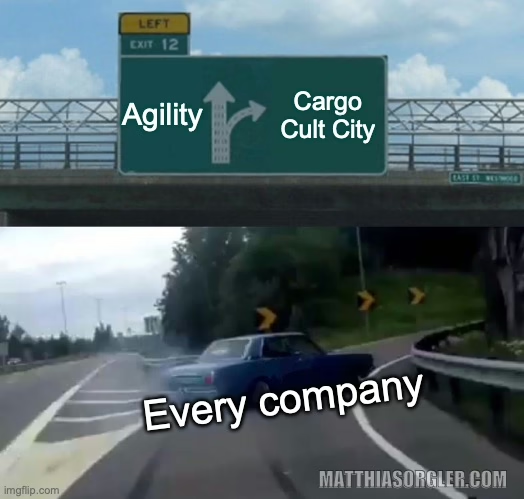The Ladder That Separates the Pretenders from the Practitioners
“We work in two-week sprints.”
Cool. That’s not agility.
I’ve heard it a hundred times. Maybe a thousand. Teams slicing a twelve-month plan into two-week chunks and calling it agile. Managers proudly announcing they “do Scrum” because they have a Jira board and a stand-up meeting. Product owners shipping nothing and collecting no feedback but still celebrating their “velocity.”
This isn’t agility. It’s project management cosplay.
Agility is simple. And hard. At its core, it means this:
You change your plan when you learn something.
That’s it.
That’s the whole thing.
But doing that? Actually doing that? Requires a cascade of uncomfortable steps. Most teams never climb the full ladder. They get stuck halfway, convincing themselves that rituals = agility.
Let’s fix that. Let’s look at what real agility demands — step by step, no bullshit.
—
🪜 The Ladder of Agility
Climb it — or keep pretending.
- Feedback Loop
You change your plan when you learn something.
Not next year. Now. - Reality Check
To learn something, you need feedback.
Not opinions. Actual signals from the real world. - Show, Don’t Tell
To get feedback, you need to show real stuff.
Not PowerPoints. Not mockups. A working product. - Get Over Yourself
To ship real stuff, you need the guts to be wrong.
That MVP might suck. Good. That’s how we learn. - You Can’t Be Brave in a Minefield
To have guts, your team needs psychological safety.
No one risks bold ideas while watching their back. - Make Failure a Feature
To feel safe, your company needs a culture that embraces failure.
Where smart risks are rewarded — not quietly punished. - Humans First
And for that, leadership needs a modern view of people.
People aren’t lazy idiots. They want to do great work — if you let them.
—
What This Really Means
If you say you’re agile, walk it up the ladder.
Do you change plans? Based on what?
Are you actually getting feedback? From real users?
Are you shipping real product increments — or just design theater?
Are your people allowed to be wrong?
Do they feel safe being wrong?
Or is your entire org allergic to uncertainty?
Every step you skip weakens the whole structure. And the further down you fall, the more you’re just pretending.
—
For Scrum Masters and Coaches
This ladder is your diagnostic tool.
The next time someone proudly tells you “we’re agile now”, pull this out. Climb with them. Step by step. Somewhere along the way, things will break down. That’s your coaching entry point. That’s the real conversation.
Because agility isn’t a checklist — it’s a culture. And culture doesn’t change with stand-ups and story points. It changes when people feel safe, empowered, and brave enough to be wrong.
—
For Leaders
This ladder gets personal.
If your team isn’t climbing, look in the mirror. What signals are you sending when someone fails? When someone admits uncertainty? Are you celebrating learning — or rewarding predictability?
Agility means not knowing, being surprised, and adapting fast. That’s not a risk to manage. That’s a superpower to unlock.
And yeah — it’s uncomfortable. That’s why most companies never get past Step 3.
—
What We Work On in the ACE Program
If you’re serious about climbing this ladder — not just talking the talk, but shifting how people feel, decide, and show up — that’s exactly what we do in the ACE program. We don’t just talk about what needs to happen. We help you actually do it.
We work on:
- Making feedback real and fast.
- Creating safety and courage on your teams.
- Breaking through limiting leadership habits.
- And yes — rewiring the culture, step by step.
Check it out if you’re ready to stop pretending and start building something real.
—
One Last Thought
Agility starts where ego ends.
No tool, no framework, no transformation deck will save you.
You’ve got to climb the ladder.
One uncomfortable step at a time.
And it’s worth it.

